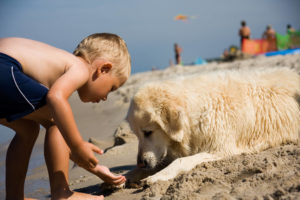

Can your pet swim?
You would be surprised by how many pet parents forget to check this one out before taking their pet to some water activities. Some breeds of dog can swim naturally. However, if you have a breed like bulldogs or pugs, it would be best to slowly introduce them to water and be especially careful if they have to swim in deep water as they can find it very difficult. It is also important to be aware of any rip currents in the water as these can be dangerous to your pet. Very lean dogs with low body fat will also struggle to maintain their buoyancy.
When introducing your pet to your backyard pool, make sure to teach them how and where to get out. This may save their life if they ever accidentally fall into the pool.
Check the water
Water can be very deceiving! It is vitally important to be aware of any rip currents as these can be catastrophic for your pet. Heavy rains can cause flooding that will result in underwater snags, debris and branches. As water recedes, swift currents are created. Freshwater may seem the safer option; however, it also tends to be a breeding ground for serious diseases such as leptospirosis. Pools, even saltwater pools, contain many chemicals, so they can become dangerous to pets if they take a liking to drink the pool water! What is the best resolution? Being equipped with the knowledge to avoid dangerous situations, is always the best buffer to prevent ill health, injury and death.
Dangerous Wildlife
Just as marine wildlife poses a threat to humans; our curious furry friends are also at risk. It is essential to keep an eye on your pet while they are frolicking around or in the water for any signs that have been affected by animals such as jellyfish or eels. Watering holes and rivers are also common habitats for snakes. Keep an eye out for them as well!
Treasure Hunt
Some new, exciting smells and goodies will appear on the beach and attract your pet’s attention almost instantly. It would be best to train your pet to obey the command “leave.” See our “Handy Handouts” on our website for some help with this command.
If they do have a cheeky snack at the beach, watch your pet for any changes in their behaviour. Keep a keen eye out for any nasty fish hooks on the beach; they can cause serious damage.
Toilet Stops
Regular toilet breaks are very important especially if you are heading out on a boat! The best times to do this would be before boarding and then straight after returning to land.
Practice
Especially if you are taking your pet out on a kayak, try practising what to do if any problems occur. Capsizing is the main problem to prepare for so that your pet does not panic and can adapt to this surprise swim.
Life Jackets
This is the safest option for your pet if they will be in the water or on a boat. Especially if your dog tires easily, this a great way to keep them secure.
Shade
Sunburn, dehydration and heatstroke are major risks to our pets. Make sure your pet has proper shade at all times. You can buy portable tents for the beach that can also act as a temporary safe place for them to sleep or rest in during the day. For more information on sunburn and heatstroke,read Life’s a Beach and Sunburn in our Pets.
Clean Drinking Water
Despite being around a water source, ensure your pet remains hydrated! Saltwater and chlorine treated water is dangerous to our furry friends. Therefore, it is vital that we have some clean water ready to give to our pet when they are feeling a little thirsty.
Bath Time
After some fun times by the water, you should give your pet a bath to remove any dirty or toxic water and to wash the salt water off.
We hope these tips and tricks help you and your pet enjoy a safe and happy time by the water! If anything unfortunate happens, seek veterinary advice immediately. Now is the perfect time to relax by the water and (safely) get some vitamin D with all our favourite people and pets!
